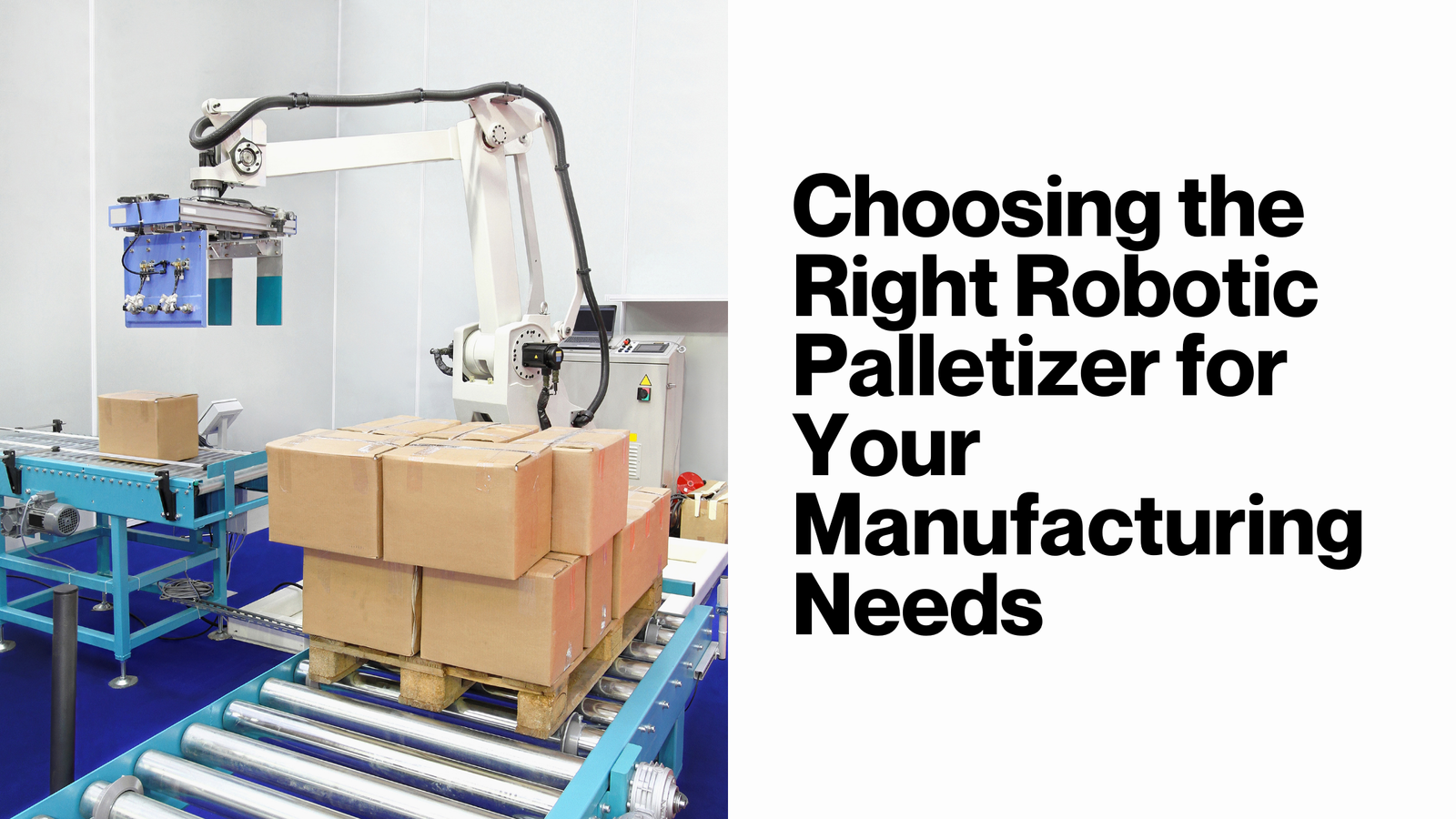In manufacturing, efficiency is the foundation of competitiveness. Every second counts, and every process that can be optimized moves you closer to meeting growing consumer demands while keeping costs under control. One area where many manufacturers are finding significant gains is end-of-line palletizing. Traditionally a labor-intensive process, palletizing has evolved into an automated, precise, and highly efficient operation thanks to robotic palletizers.
Manual palletizing comes with challenges: it’s slow, physically demanding, and prone to stacking errors that lead to product damage or shipping inefficiencies. Robotic palletizers eliminate these issues, offering speed, flexibility, and reliability. But with so many options on the market, the real question is: how do you choose the right robotic palletizer for your business needs?
This comprehensive guide explores everything you need to know—how robotic palletizers work, their benefits, types, cost considerations, and factors to evaluate before investing in automation.
What Is a Robotic Palletizer and Why It Matters
A robotic palletizer is an automated machine that arranges products like boxes, bags, or cartons onto pallets in a defined pattern for storage or shipping. Unlike traditional palletizers, robotic systems are flexible, programmable, and adaptable to various packaging formats.
For example, imagine a beverage manufacturer handling glass bottles, multipack cartons, and shrink-wrapped trays on the same production line. Instead of requiring multiple manual teams or machines, a single robotic palletizer can handle all three seamlessly, adjusting its grip, stacking pattern, and cycle speed in real time.
Why More Manufacturers Are Adopting Robotic Palletizers
Manufacturers aren’t just switching to robotic palletizers for convenience—they’re doing it because the benefits are tangible and measurable.
Enhanced Speed and Throughput
Robotic palletizers work continuously, stacking hundreds of cartons per hour without breaks or fatigue. High-speed operations that once required large teams of manual laborers can now be handled by a single automated system.
Consistency and Precision
Poorly stacked pallets can lead to collapsed loads, damaged products, and unhappy customers. Robotic palletizers ensure perfectly uniform stacks every time, improving stability and minimizing losses.
Improved Workplace Safety
Repetitive lifting, bending, and twisting are common causes of workplace injuries in manufacturing. Robotic systems remove employees from hazardous, physically demanding tasks, creating safer work environments.
Optimized Labor Allocation
Labor shortages have impacted industries worldwide. With palletizing automated, manufacturers can redeploy workers to quality checks, supervision, and other value-driven activities.
Flexibility to Handle Multiple SKUs
Modern manufacturing lines often handle mixed product sizes, shapes, and packaging formats. Robotic palletizers adapt quickly to changing product types without complex reconfiguration, making them ideal for diverse production environments.
Types of Robotic Palletizers and Their Applications
The best robotic palletizer depends on your products, production speed, and available space. Here are the main types and where each excels:
Cartesian Robotic Palletizers
Operating on linear X, Y, and Z axes, these systems are known for precision and durability. They’re ideal for stacking uniform loads at high volumes but less flexible for irregular patterns or mixed SKUs.
Best suited for: Large-scale food, beverage, and chemical industries where stacking patterns rarely change.
Articulated Arm Robotic Palletizers
Equipped with a multi-jointed robotic arm, these palletizers offer exceptional reach and flexibility. Their compact footprint makes them perfect for facilities where floor space is limited but product diversity is high.
Best suited for: FMCG, pharmaceuticals, and e-commerce operations managing varied packaging formats.
Gantry and Hybrid Palletizers
These systems use an overhead structure to move products into place, making them ideal for heavy-duty applications. While they require more floor space, they deliver unmatched power and precision for bulky or heavy products.
Best suited for: Agriculture, grains, construction materials, and industrial manufacturing.
Collaborative Robot (Cobot) Palletizers
Cobots are designed to work safely alongside human operators without additional safety fencing. They are lightweight, easy to program, and cost-effective, making them perfect for businesses taking their first step into automation.
Best suited for: SMEs, startups, and facilities running shorter production cycles.
Key Factors to Consider When Choosing a Robotic Palletizer
Selecting the right system requires a thorough understanding of your production goals, packaging requirements, and facility constraints.
Production Volume and Speed
Estimate your current throughput and future growth. A palletizer should meet today’s needs and scale with your business to avoid early obsolescence.
Product Specifications
Different products demand different handling solutions. Consider product weight, dimensions, fragility, and packaging material to ensure compatibility with your chosen palletizer.
Integration with Existing Systems
Your robotic palletizer should integrate smoothly with upstream systems like conveyors, case packers, stretch wrappers, and warehouse management software. Seamless integration improves overall efficiency and minimizes operational disruptions.
Available Floor Space
Facilities with limited space may benefit from compact articulated arms or cobots, while larger operations with heavier loads can leverage gantry systems.
Budget and ROI
While robotic palletizers involve upfront costs, they often deliver payback in less than three years through reduced labor costs, fewer product damages, and higher productivity. Evaluate total cost of ownership (TCO) rather than focusing solely on the purchase price.
Real-World Applications Across Industries
Robotic palletizers are transforming operations across sectors by solving unique challenges in each:
- FMCG & Beverages: High-speed stacking of mixed SKUs to support mass production and distribution
- Pharmaceuticals: Precise handling to ensure compliance and maintain product integrity
- Agriculture: Efficient palletizing of heavy sacks, grains, seeds, and fertilizers
- E-commerce & Retail: Flexible handling of varied box sizes for rapid order fulfillment
By automating palletizing, manufacturers in these industries not only speed up operations but also reduce errors, minimize damages, and boost overall profitability.
Common Mistakes to Avoid
When investing in robotic palletizers, manufacturers often make costly mistakes such as:
- Choosing a system that meets current needs but cannot scale with growing production demands
- Overlooking integration costs and assuming compatibility with existing equipment
- Underestimating the importance of training and after-sales support
- Selecting solutions based purely on lowest price rather than evaluating long-term ROI
Avoiding these pitfalls ensures your investment delivers maximum returns.
The Future of Robotic Palletizing
Robotic palletizing is evolving rapidly as AI, IoT, and predictive analytics redefine manufacturing automation. Future-ready palletizers will feature:
- AI-powered vision systems for real-time product recognition
- Predictive maintenance capabilities to minimize downtime
- IoT connectivity for remote monitoring and performance optimization
- Collaborative robot integration for more versatile production environments
The rise of Industry 4.0 is driving smarter, faster, and more connected palletizing solutions that give manufacturers a competitive advantage.
Take the Next Step Toward Smarter Automation
Choosing the right robotic palletizer goes beyond simply automating the stacking process—it’s about redefining your entire manufacturing workflow. The right solution can significantly boost throughput, improve workplace safety, reduce operational costs, and set the stage for future-ready production lines.
For businesses looking to streamline packaging and end-of-line operations, exploring advanced Automatic Bagging Solutions in Australia can be a game-changer. With tailored systems that integrate seamlessly into existing setups, manufacturers can unlock higher efficiency, consistent quality, and smarter handling without unnecessary complexity.
Automation isn’t just an upgrade—it’s an investment in growth, scalability, and long-term success. Now is the time to evaluate your needs and adopt solutions that take your manufacturing performance to the next level.





